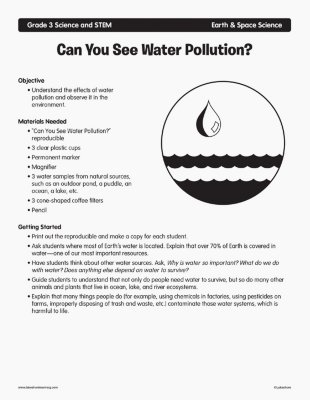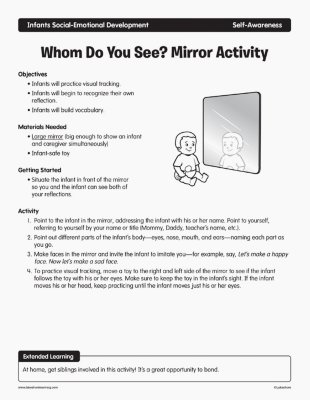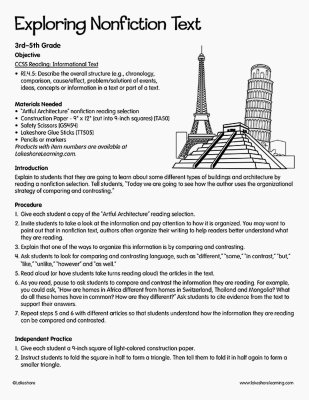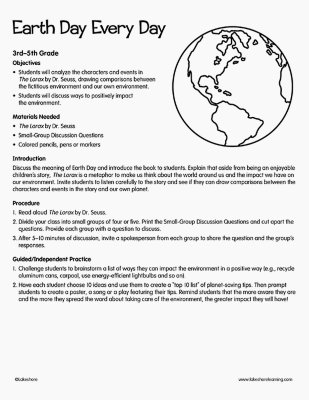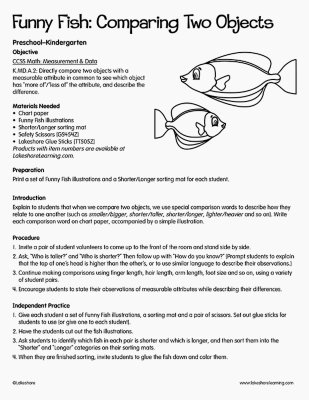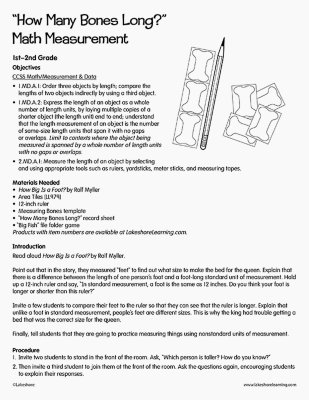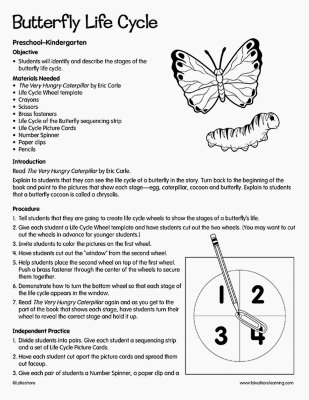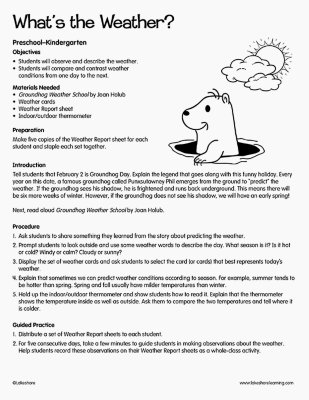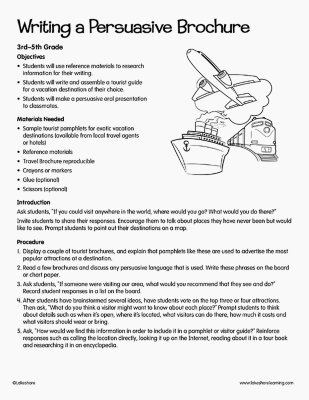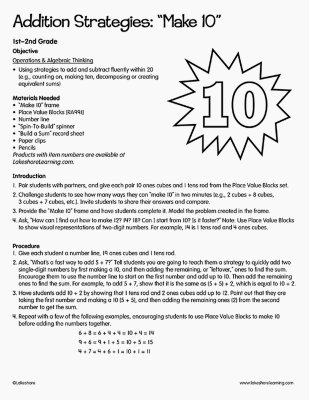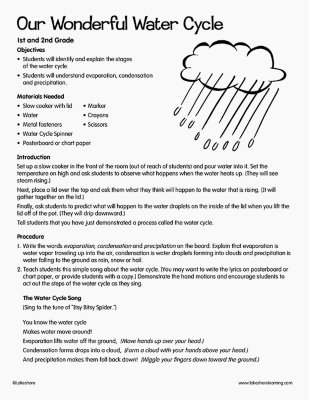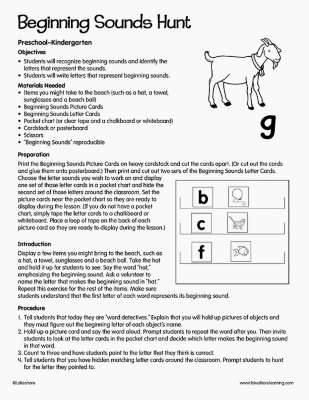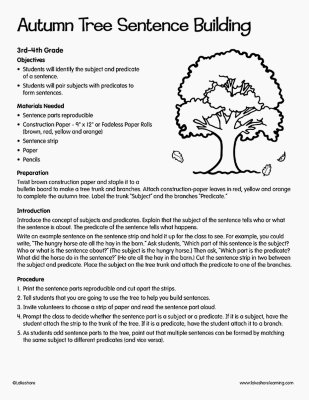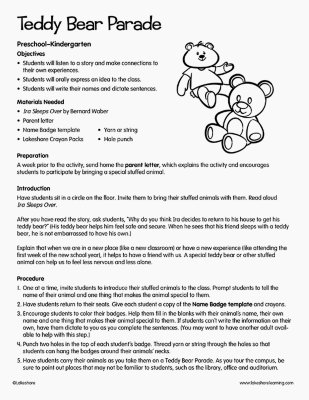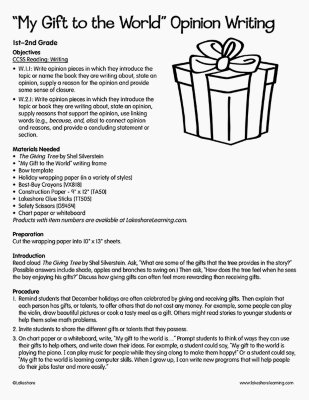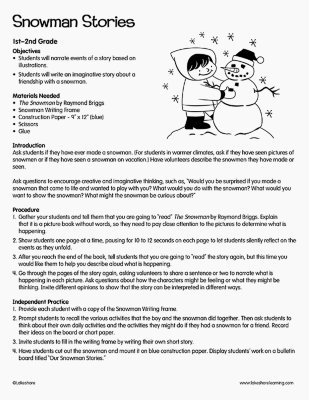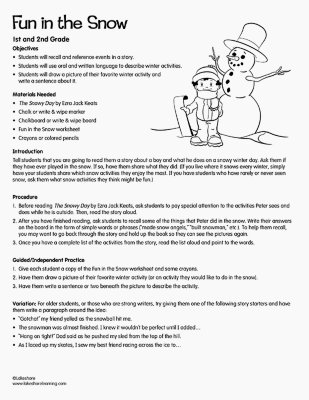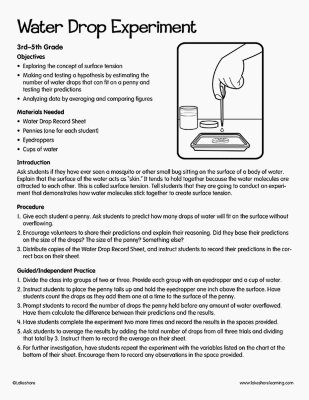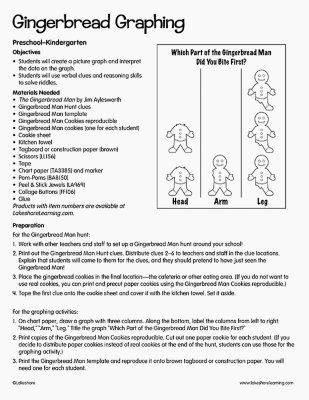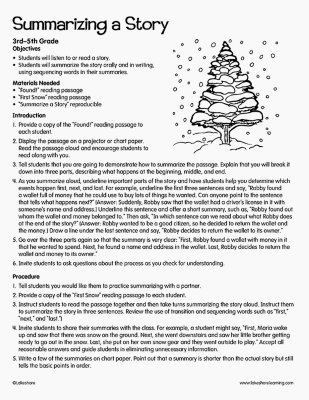Narrow by Grade
Grade
20 results for "see"
Can You See Water Pollution?
3rd Grade
Objective
- Understand the effects of water pollution and observe it in the environment.
Whom Do You See? Mirror Activity
Infant
Objectives
• Infants will practice visual tracking.
• Infants will begin to recognize their own reflection.
• Infants will build vocabulary.
Exploring Nonfiction Text
1st Grade - 2nd Grade
Objective CCSS Reading: Informational Text RI.4.5: Describe the overall structure (e.g., chronology, comparison, cause/effect, problem/solution) of events, ideas, concepts or information in a text or part of a text. Materials Needed “Artful Architecture” nonfiction reading selection Construction Paper - 9" x 12" (cut into 9-inch squares) Safety Scissors Lakeshore Glue Sticks Pencils or markers Introduction Explain to students that they are going to learn about some different types of buildings and architecture by reading a nonfiction selection. Tell students, “Today we are going to see how the author uses the organizational strategy of comparing and contrasting.”
View Lesson PlanEarth Day Every Day
3rd Grade - 5th Grade
Objectives Students will analyze the characters and events in The Lorax by Dr. Seuss, drawing comparisons between the fictitious environment and our own environment. Students will discuss ways to positively impact the environment. Materials Needed The Lorax by Dr. Seuss Small-Group Discussion Questions Colored pencils, pens or markers Introduction Discuss the meaning of Earth Day, and introduce the book to students. Explain that aside from being an enjoyable children’s story, The Lorax is a metaphor to make us think about the world around us and the impact we have on our environment. Invite students to listen carefully to the story and see if they can draw comparisons between the characters and events in the story and our own planet.
View Lesson PlanFunny Fish: Comparing Two Objects
Kindergarten
Objective CCSS Math: Measurement & Data K.MD.A.2: Directly compare two objects with a measurable attribute in common to see which object has “more of”/“less of” the attribute, and describe the difference. Materials Needed Chart paper Funny Fish illustrations Shorter/Longer sorting mat Safety Scissors Lakeshore Glue Sticks Introduction Explain to students that when we compare two objects, we use special comparison words to describe how they relate to one another (such as smaller/bigger, shorter/taller, shorter/longer, lighter/heavier and so on). Write each comparison word on chart paper, accompanied by a simple illustration.
View Lesson Plan"How Many Bones Long?" Math Measurement
1st Grade - 2nd Grade
Objectives CCSS Math/Measurement & Data 1.MD.A.1: Order three objects by length; compare the lengths of two objects indirectly by using a third object. 1.MD.A.2: Express the length of an object as a whole number of length units, by laying multiple copies of a shorter object (the length unit) end to end; understand that the length measurement of an object is the number of same-size length units that span it with no gaps or overlaps. Limit to contexts where the object being measured is spanned by a whole number of length units with no gaps or overlaps. 2.MD.A.1: Measure the length of an object by selecting and using appropriate tools such as rulers, yardsticks, meter sticks, and measuring tapes. Materials Needed How Big Is a Foot? by Rolf Myller Area Tiles 12-inch ruler Measuring Bones template “How Many Bones Long?” record sheet “Big Fish” file folder game Introduction Read aloud How Big Is a Foot? by Rolf Myller. Point out that in the story, they measured “feet” to find out what size to make the bed for the queen. Explain that there is a difference between the length of one person’s foot and a foot-long standard unit of measurement. Hold up a 12-inch ruler and say, “In standard measurement, a foot is the same as 12 inches. Do you think your foot is longer or shorter than this ruler?” Invite a few students to compare their feet to the ruler so that they can see that the ruler is longer. Explain that unlike a foot in standard measurement, people’s feet are different sizes. This is why the king had trouble getting a bed that was the correct size for the queen. Finally, tell students that they are going to practice measuring things using nonstandard units of measurement.
View Lesson PlanButterfly Life Cycle
Pre-K
Objective Students will identify and describe the stages of the butterfly life cycle. Materials Needed The Very Hungry Caterpillar by Eric Carle Life Cycle Wheel template Crayons Scissors Brass fasteners Life Cycle of the Butterfly sequencing strip Life Cycle Picture Cards Number Spinner Paper clips Pencils Introduction Read The Very Hungry Caterpillar by Eric Carle. Explain to students that they can see the life cycle of a butterfly in the story. Turn back to the beginning of the book and point to the pictures that show each stage—egg, caterpillar, cocoon and butterfly. Explain to students that a butterfly cocoon is called a chrysalis.
View Lesson PlanWhat’s the Weather?
Kindergarten
Objectives Students will observe and describe the weather. Students will compare and contrast weather conditions from one day to the next. Materials Needed Groundhog Weather School by Joan Holub Weather cards Weather Report sheet Indoor/outdoor thermometer Preparation Make five copies of the Weather Report sheet for each student and staple each set together. Introduction Tell students that February 2 is Groundhog Day. Explain the legend that goes along with this funny holiday. Every year on this date, a famous groundhog called Punxsutawney Phil emerges from the ground to “predict” the weather. If the groundhog sees his shadow, he is frightened and runs back underground. This means there will be six more weeks of winter. However, if the groundhog does not see his shadow, we will have an early spring! Next, read aloud Groundhog Weather School by Joan Holub.
View Lesson PlanWriting a Persuasive Brochure
3rd Grade - 5th Grade
Objectives Using reference materials to research for their writing Introducing the topic or text they are writing about, stating an opinion and creating an organizational structure that lists reasons Providing reasons that support the opinion Reporting on a topic or text, telling a story, or recounting an experience in an organized manner, using appropriate facts and relevant, descriptive details to support main ideas or themes; speaking clearly at an understandable pace Materials Needed Sample tourist pamphlets for exotic vacation destinations (available from local travel agents or hotels) Reference materials Travel Brochure reproducible Crayons or markers Glue (optional) Scissors (optional) Introduction Ask students, “If you could visit anywhere in the world, where would you go? What would you do there?” Invite students to share their responses. Encourage them to talk about places they have never been but would like to see. Prompt students to point out their destinations on a map.
View Lesson PlanAddition Strategies: "Make 10"
1st Grade - 2nd Grade
Objective Operations & Algebraic Thinking Using strategies to add and subtract fluently within 20 (e.g., counting on, making ten, decomposing or creating equivalent sums) Materials Needed “Make 10” frame Place Value Blocks Number line “Spin-To-Build” spinner “Build a Sum” record sheet Paper clips Pencils Introduction Pair students with partners, and give each pair 10 ones cubes and 1 tens rod from the Place Value Blocks set. Challenge students to see how many ways they can “make 10” in two minutes (e.g., 2 cubes + 8 cubes, 3 cubes + 7 cubes, etc.). Invite students to share their answers and compare. Provide the “Make 10” frame and have students complete it. Model the problem created in the frame. Ask, “How can I find out how to make 12? 14? 18? Can I start from 10? Is it faster?” Note: Use Place Value Blocks to show visual representations of two-digit numbers. For example, 14 is 1 tens rod and 4 ones cubes.
View Lesson PlanOur Wonderful Water Cycle
1st Grade - 2nd Grade
Objectives Students will identify and explain the stages of the water cycle. Students will understand evaporation, condensation and precipitation. Materials Needed Slow cooker with lid Water Posterboard or chart paper Marker Water Cycle Spinner Crayons Scissors Metal fasteners Introduction Set up a slow cooker in the front of the room (out of reach of students) and pour water into it. Set the temperature on high and ask students to observe what happens when the water heats up. (They will see steam rising.) Next, place a lid over the top and ask them what they think will happen to the water that is rising. (It will gather together on the lid.) Finally, ask students to predict what will happen to the water droplets on the inside of the lid when you lift the lid off of the pot. (They will drip downward.) Tell students that you have just demonstrated a process called the water cycle.
View Lesson PlanBeginning Sounds Hunt
Pre-K - Kindergarten
Objectives Students will recognize beginning sounds and identify the letters that represent the sounds. Students will write letters that represent beginning sounds. Materials Needed Items you might take to the beach (such as a hat, a towel, sunglasses and a beach ball) Beginning Sounds Picture Cards Beginning Sounds Letter Cards Pocket chart (or clear tape and a chalkboard or whiteboard) Cardstock or posterboard Scissors “Beginning Sounds” reproducible Preparation: Print the Beginning Sounds Picture Cards on heavy cardstock and cut the cards apart. (Or cut out the cards and glue them onto posterboard.) Then print and cut out two sets of the Beginning Sounds Letter Cards. Choose the letter sounds you wish to work on and display one set of those letter cards in a pocket chart and hide the second set of those letters around the classroom. Set the picture cards near the pocket chart so they are ready to display during the lesson. (If you do not have a pocket chart, simply tape the letter cards to a chalkboard or whiteboard. Place a loop of tape on the back of each picture card so they are ready to display during the lesson.) Introduction Display a few items you might bring to the beach, such as a hat, a towel, sunglasses and a beach ball. Take the hat and hold it up for students to see. Say the word “hat,” emphasizing the beginning sound. Ask a volunteer to name the letter that makes the beginning sound in “hat.” Repeat this exercise for the rest of the items. Make sure students understand that the first letter of each word represents its beginning sound.
View Lesson PlanAutumn Tree Sentence Building
3rd Grade - 4th Grade
Objectives Students will identify the subject and predicate of a sentence. Students will pair subjects with predicates to form sentences. Materials Needed Sentence parts reproducible Construction Paper - 9" x 12" or Fadeless Paper Rolls (brown, red, yellow and orange) Sentence strip Paper Pencils Preparation: Twist brown construction paper and staple it to a bulletin board to make a tree trunk and branches. Attach construction-paper leaves in red, yellow and orange to complete the autumn tree. Label the trunk “Subject” and the branches “Predicate.” Introduction Introduce the concept of subjects and predicates. Explain that the subject of the sentence tells who or what the sentence is about. The predicate of the sentence tells what happens. Write an example sentence on the sentence strip and hold it up for the class to see. For example, you could write, “The hungry horse ate all the hay in the barn.” Ask students, “Which part of this sentence is the subject? Who or what is the sentence about?” (The subject is the hungry horse.) Then ask, “Which part is the predicate? What did the horse do in the sentence?” (He ate all the hay in the barn.) Cut the sentence strip in two between the subject and predicate. Place the subject on the tree trunk and attach the predicate to one of the branches.
View Lesson PlanTeddy Bear Parade
Pre-K
Objectives Students will listen to a story and make connections to their own experiences. Students will orally express an idea to the class. Students will write their names and dictate sentences. Materials Needed Ira Sleeps Over by Bernard Waber Parent letter Name Badge template Yarn or string Lakeshore Crayon Packs Hole punch Preparation: A week prior to the activity, send home the parent letter, which explains the activity and encourages students to participate by bringing a special stuffed animal. Introduction Have students sit in a circle on the floor. Invite them to bring their stuffed animals with them. Read aloud Ira Sleeps Over. After you have read the story, ask students, “Why do you think Ira decides to return to his house to get his teddy bear?” (His teddy bear helps him feel safe and secure. When he sees that his friend sleeps with a teddy bear, he is not embarrassed to have his own.) Explain that when we are in a new place (like a new classroom) or have a new experience (like attending the first week of the new school year), it helps to have a friend with us. A special teddy bear or other stuffed animal can help us to feel less nervous and less alone.
View Lesson PlanMy Gift to the World Opinion Writing
1st Grade - 2nd Grade
Objectives CCSS Reading: Writing W.1.1: Write opinion pieces in which they introduce the topic or name the book they are writing about, state an opinion, supply a reason for the opinion and provide some sense of closure. W.2.1: Write opinion pieces in which they introduce the topic or book they are writing about, state an opinion, supply reasons that support the opinion, use linking words (e.g., because, and, also) to connect opinion and reasons, and provide a concluding statement or section. Materials Needed The Giving Tree by Shel Silverstein “My Gift to the World” writing frame Bow template Holiday wrapping paper (in a variety of styles) Best-Buy Crayons Construction Paper - 9" x 12" Lakeshore Glue Sticks Safety Scissors Chart paper or whiteboard Preparation: Cut the wrapping paper into 10" x 13" sheets. Introduction Read The Giving Tree by Shel Silverstein. Ask, “What are some of the gifts that the tree provides in the story?” (Possible answers include shade, apples and branches to swing on.) Then ask, “How does the tree feel when he sees the boy enjoying his gifts?” Discuss how giving gifts can often feel more rewarding than receiving gifts.
View Lesson PlanSnowman Stories
1st Grade
Objectives Students will narrate events of a story based on illustrations. Students will write an imaginative story about a friendship with a snowman. Materials Needed The Snowman by Raymond Briggs Snowman Writing Frame Construction Paper - 9" x 12" (blue) Scissors Glue Introduction Ask students if they have ever made a snowman. (For students in warmer climates, ask if they have seen pictures of snowmen or if they have seen a snowman on vacation.) Have volunteers describe the snowmen they have made or seen. Ask questions to encourage creative and imaginative thinking, such as, “Would you be surprised if you made a snowman that came to life and wanted to play with you? What would you do with the snowman? What would you want to show the snowman? What might the snowman be curious about?”
View Lesson PlanFun in the Snow
1st Grade - 2nd Grade
Objective Students will recall and reference events in a story. Students will use oral and written language to describe winter activities. Students will draw a picture of their favorite winter activity and write a sentence about it. Materials Needed The Snowy Day by Ezra Jack Keats Chalk or write & wipe marker Chalkboard or write & wipe board Fun in the Snow Worksheet Crayons or colored pencils Introduction Tell students that you are going to read them a story about a boy and what he does on a snowy winter day. Ask them if they have ever played in the snow. If so, have them share what they did. (If you live where it snows every winter, simply have your students share which snow activities they enjoy the most. If you have students who have rarely or never seen snow, ask them what snow activities they think might be fun.)
View Lesson PlanWater Drop Experiment
4th Grade
Objectives Exploring the concept of surface tension Making and testing a hypothesis by estimating the number of water drops that can fit on a penny and testing their predictions Analyzing data by averaging and comparing figures Materials Needed Water Drop Record Sheet Pennies (one for each student) Eyedroppers Cups of water Introduction Ask students if they have ever seen a mosquito or other small bug sitting on the surface of a body of water. Explain that the surface of the water acts as “skin.” It tends to hold together because the water molecules are attracted to each other. This is called surface tension. Tell students that they are going to conduct an experiment that demonstrates how water molecules stick together to create surface tension.
View Lesson PlanGingerbread Graphing
Pre-K
Objectives Students will create a picture graph and interpret the data on the graph. Students will use verbal clues and reasoning skills to solve riddles. Materials Needed The Gingerbread Man by Jim Aylesworth Gingerbread Man Hunt clues Gingerbread Man template Gingerbread Man Cookies reproducible Scissors Gingerbread Man cookies (one for each student) Cookie sheet Kitchen towel Tagboard or construction paper (brown) Tape Chart paper and marker Pom-Poms Peel & Stick Jewels Collage Buttons Glue Preparation: For the Gingerbread Man hunt: Work with other teachers and staff to set up a Gingerbread Man hunt around your school! Print out the Gingerbread Man Hunt clues. Distribute clues 2 - 6 to the teachers and staff in the clue locations. Explain that students will come to them for the clues, and they should pretend to have just seen the Gingerbread Man! Place the gingerbread cookies in the final location—the cafeteria or other eating area. (If you do not want to use real cookies, you can print and precut paper cookies using the Gingerbread Man Cookies reproducible.) Tape the first clue onto the cookie sheet and cover it with the kitchen towel. Set it aside. For the graphing activities: On chart paper, draw a graph with three columns. Along the bottom, label the columns from left to right: “Head,” “Arm,” and “Leg.” Title the graph “Which Part of the Gingerbread Man Did You Bite First?” Print copies of the Gingerbread Man Cookies reproducible. Cut out one paper cookie for each student. (If you decide to distribute paper cookies instead of real cookies at the end of the hunt, students can use those for the graphing activity.) Print the Gingerbread Man template and reproduce it onto brown tagboard or construction paper. You will need one for each student. Introduction Read aloud The Gingerbread Man by Jim Aylesworth. After the story, tell students that you have prepared a Gingerbread Man cookie for them to eat. (If you are not using real cookies, tell students you have made a paper cookie for them to use in a special math project.) Then take out the covered cookie sheet and pull off the towel. Act surprised as you announce, “Oh no, our Gingerbread Man has run away! Look, he left a note for us to read!” Read the clue aloud to students.
View Lesson PlanSummarizing a Story
4th Grade
Objectives Students will listen to or read a story. Students will summarize the story in writing, using sequencing words in their summaries. Materials Needed “Found!” reading passage “First Snow” reading passage “Summarize a Story” reproducible Introduction Provide a copy of the “Found!” reading passage to each student. Display the passage on a projector or chart paper. Read the passage aloud and encourage students to read along with you. Tell students that you are going to demonstrate how to summarize the passage. Explain that you will break it down into three parts, describing what happens at the beginning, middle, and end. As you summarize aloud, underline important parts of the story and have students help you determine which events happen first, next, and last. For example, underline the first three sentences and say, “Robby found a wallet full of money that he could use to buy lots of things he wanted. Can anyone point to the sentence that tells what happens next?” (Answer: Suddenly, Robby saw that the wallet had a driver’s license in it with someone’s name and address.) Underline this sentence and offer a short summary, such as, “Robby found out whom the wallet and money belonged to.” Then ask, “In which sentence can we read about what Robby does at the end of the story?” (Answer: Robby wanted to be a good citizen, so he decided to return the wallet and the money.) Draw a line under the last sentence and say, “Robby decides to return the wallet to its owner.” Go over the three parts again so that the summary is very clear: “First, Robby found a wallet with money in it that he wanted to spend. Next, he found a name and address in the wallet. Last, Robby decides to return the wallet and money to its owner.” Invite students to ask questions about the process as you check for understanding.
View Lesson Plan